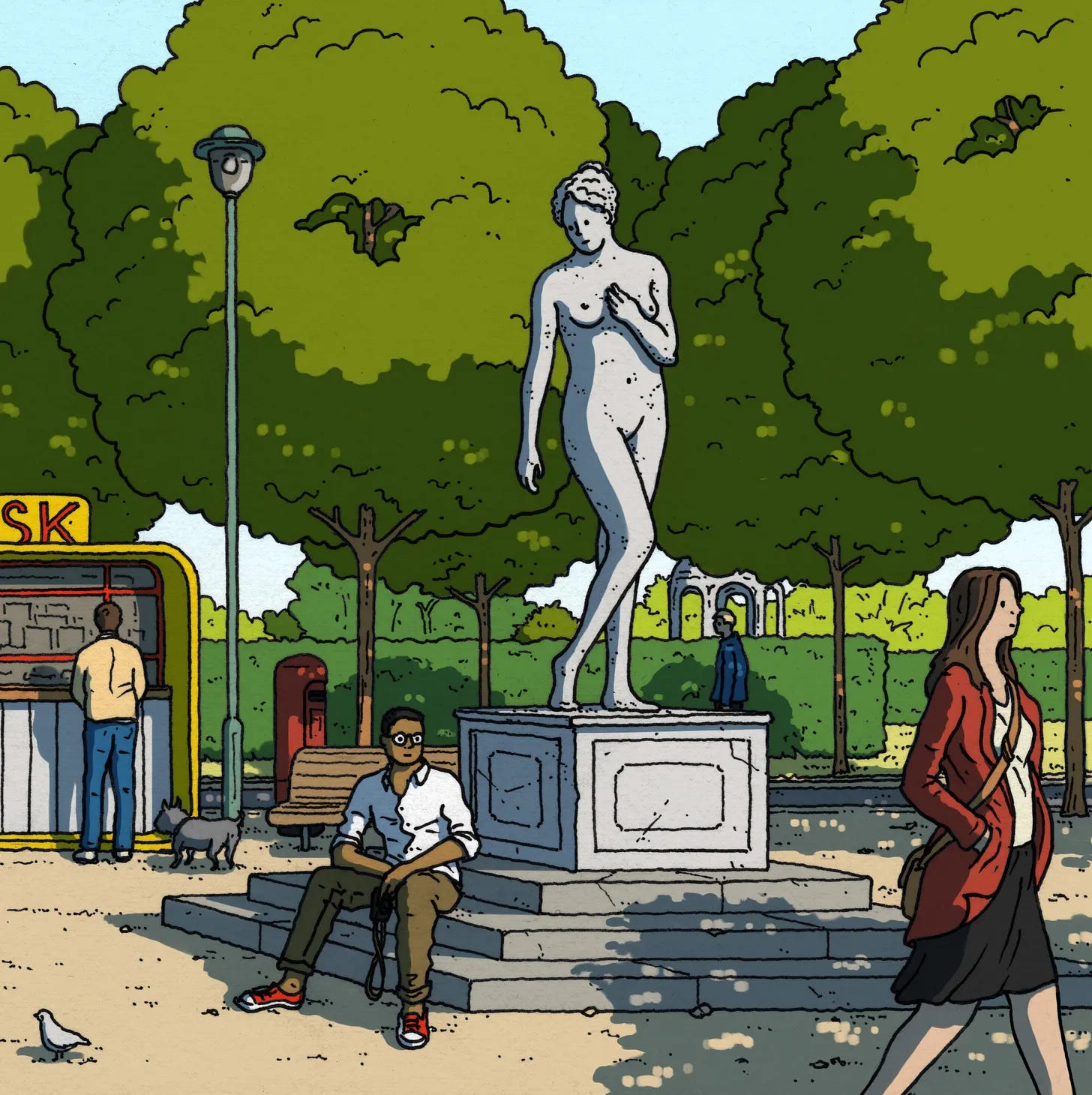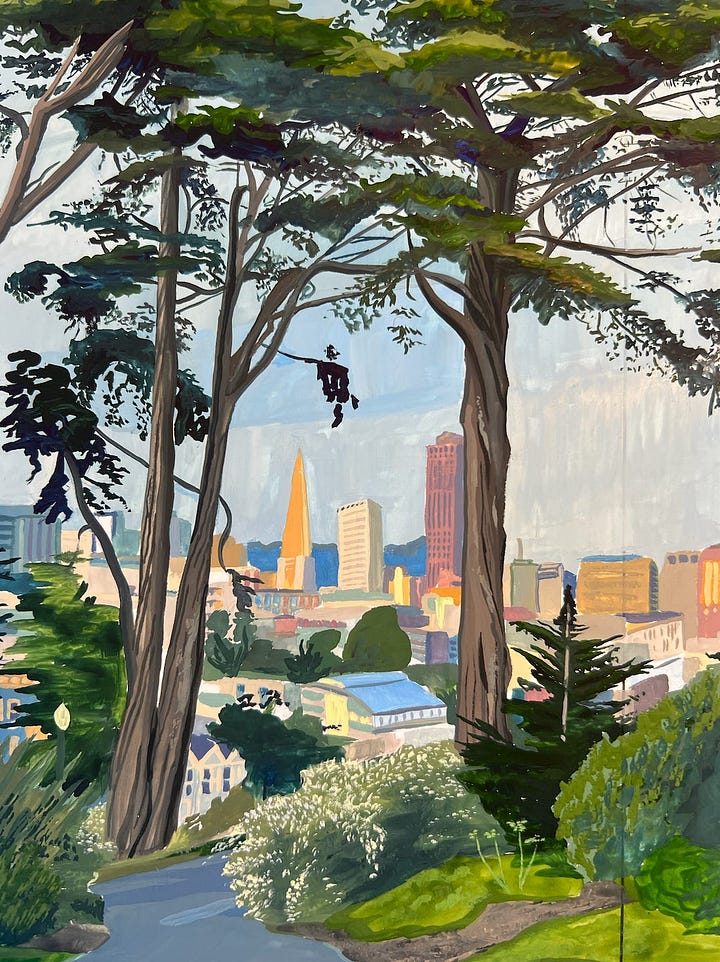“How much of my reality has been distorted for all of these years?”
In this edition of the Weekender: the miracle of LASIK, trends in animation, and an investigation of celebrity stalkers

This week, we’re seeing things clearly, analyzing dating data, annotating film scenes, and learning how to prepare an artichoke.
SIGHT
Vision quest
Nikhil writes about the miracle of LASIK, and what it’s like to see the world—and oneself—through new eyes.
Seeing and believing
—
inAt first, I could see shapes and forms that I couldn’t before, but with a level of blurriness that made it imperfect. With each day, my vision improved slightly, as I could make out more and more. Six days post-op, I see mostly as I did with glasses, though there’s a slight glare around sources of light. In my awe, I find this beautiful. The sun pours onto the breakfast table, cut into lines by the blinds and glowing as if imbued with a divine presence. Every light acts this way, and I feel grateful to see any of it.
So much is different. When you wear glasses with as high an index of refraction as I did, things close up look smaller than they are. Every time I see my hands, I feel slightly alarmed by the size of them. Everything is bigger close-up than I always thought. How much of my reality has been distorted for all of these years? My own body seems grotesque in its unfamiliarity. Every time I pass a mirror, it takes me a moment to recognize myself—I was so used to my eyes being framed and shrunken by my plastic frames, the sides of my face made narrower by the lenses. I didn’t know my eyes were this big, I didn’t know how my nose looked in proportion to them.
In the weeks leading up to the operation, I joked that I would have an identity crisis after this minor operation, and part of me wonders if I was right. I have always been vain, but my entire self-image has been disrupted. I have always been a man of science, but the change feels more like magic than medicine. Through this act of the objective and scientific, my subjective experience is permanently altered. My senses are how I interact with the world, how I take in all that shapes my mind and lifestyle. This physical change feels like it alters the metaphysical, alters the information that fuels my interpretation of the world, and thus feels like something greater. Something nearly divine.
PAINTING

CRIME
Celebrity stalkers
Alexandra Paul, best known for her role on Baywatch, writes about the chilling ubiquity of celebrity stalkers—and recounts her personal experiences with one over the course of 13 years.
Stalked: A ‘Baywatch’ Star’s 13-Year Nightmare
—
inThe subject of celebrity stalking brings to mind high-profile cases, like the man who tried to impress Jodie Foster by attempting to assassinate President Ronald Reagan, and the murder of John Lennon by the longtime Beatles fan who became infuriated by Lennon’s quip that the band was more popular than Jesus. (I will not use the name of any perpetrator in this article, as experts advise that you should never give a stalker the satisfaction of seeing their name in print.) But it was the murder of the young actress Rebecca Schaeffer in 1989 that was the catalyst for the Los Angeles Police Department to form the Threat Management Unit (TMU) the following year, working with studios to identify problem fans and protect public figures.
Schaeffer, who starred on the sitcom My Sister Sam, was shot point-blank by an admirer who was angry at her for a bedroom scene she filmed in a movie after the TV series ended. He had appeared several times at the Warner Brothers lot where her series was taped, asking to see her—once armed with a knife—and had been turned away by security guards but never apprehended. After paying a private detective $250 to find her home address through DMV records, the stalker rang her doorbell and, when she answered the door of her apartment building thinking it was a script being delivered, fired a gun at her chest. Rebecca Schaeffer was 21 years old.
The Threat Management Unit is a unique team within the LAPD. It has seven officers who work on about 275 public figure cases a year, including the harassment of politicians, high-profile executives, athletes, musicians, actors and influencers. They are skilled at identifying and stopping inappropriate pursuit before things go too far. In fact, only 30 or so of these cases get to the point where charges are filed each year. The unit works closely with the police department’s mental health teams to deal with the complicated motivations of the stalker. Detective Pete Doomanis, one of three supervisors at TMU, says, “As soon as the hairs on the back of your neck stand up, I want to nip it in the bud. Then I can connect them to appropriate services, to their families, or get them into diversion programs. I sit right next to a psychologist, and there is not a day that goes by that we do not consult together on a case.”
[...]
The advent of social media makes combating stalking both harder and easier, Doomanis tells me. It’s more difficult because celebrities are often so open, posting what they’re doing and where they’re doing it, and writing so personally that someone with mental illness can feel a deep connection. And public figures post a lot of photos that inadvertently give away clues to their whereabouts. “We have cases where stalkers have identified the mountains in the distance in a video and figured out where their target was,” Doomanis says. “Remember, these individuals spend as much time at their job—which is tracking their celebrity—as we do. Eight to 10 hours a day is not uncommon.” On the other hand, he continues, the internet “makes my work easier because the stalkers post too. They comment about their obsession on Instagram, in Reddit chat rooms, on TikTok.”
Doomanis believes 100 percent of A-listers in the United States “always have some type of pursuer, whether a true stalker or someone exhibiting stalker-like behavior.”
ANNOTATIONS
FILM
A brief history of animation
As a live-action Snow White bombs at the box office, the team at Animation Obsessive reviews what made the original such a success—and why the Disney method fell off as more avant-garde styles became popular in the middle of the 20th century.
Who Cares About the Disney Method?
—
inThe world shifted with Snow White. It was 1937, almost nine decades ago. The Disney team had honed itself on short films—hundreds of them. That practice and experimentation finally led to this feature.
And it was a feature unlike any before. The studio crafted a storybook world full of living animated characters, each with their own identity. It was a spectacle, a special-effects movie, a musical. It was funny, emotional—and frightening.
“Critics continue to bewail the scary atmosphere of parts of Snow White and the Seven Dwarfs,” the press reported soon after the premiere, “and today Walt Disney took time out to explain the picture is intended for adults, not for small children.”
The film held up to adult eyes—even to the eyes of the modernists, in some cases. Reviews were glowing; the public loved it. Disney had a hit. Although it wasn’t the first animated classic, or even the first animated feature, it was something powerful. Animation had advanced.
No one element made Snow White: it was a team effort. Still, it’s hard to ignore the animation technique that lent believability to these characters and their feelings. Walt Disney and his team had developed this technique since the ’20s—aiming to make drawings that weren’t drawings but animated personalities.
It was a set of tools. Some later got famous as the “12 principles of animation,” but they weren’t all—there were a thousand little things involved. See the reference footage of live actors, at times traced outright. See the borrowings from vaudeville and stage musicals. See the focus on rounded edges (“balls, ovals, eggs and pear shapes,” per the book Cartoon Modern), and on realism and old-school cartooning over modernist approaches to figure.
Snow White showed how well this mix of ideas could work. Animators like Art Babbitt, Bill Tytla and Milt Kahl brought these characters to life. Yet it was an ultra-specific mix of ideas, and one somewhat resistant to change.
We wrote last year about the breakaway from Disney animation. It was an eruption in the ’40s, ’50s and ’60s. Disney’s style had been the standard for animators around the world—but, now, many wanted something new.
ILLUSTRATION

RELATIONSHIPS
Dating data
Danielle added a Google Form to her dating profiles as a joke. But after receiving over 400 responses, she “felt an obligation to the scientific community to write a research paper.”
Marked Variation in Mating Tendencies of Northern California Males Aged 23-29: A Systematic Review and Meta-Analysis
—
in1. Introduction
Do you ever look at your love life and think—wow, this is so inefficient, I really need to optimize this? Probably not. This is what separates me from you.
Bored of dating in the Bay Area, I was either going to gamify my love life to biohack some serotonin or else give up entirely. After a statistically significantly disappointing date, I was struck by inspiration—by the hour of 1:38 ante meridian, I had composed a manifesto that encapsulated the tropes of the modern dating [age]. I shared it with some friends as yet another high-effort joke, and they insisted I put it on my dating profile. At first I refused—would I really ascend to such cosmic levels of cringe? Clearly, yes.
Once I reached a critical mass of respondents, of course I was going to conduct some data analysis. I literally make spreadsheets for a living.
2. Patients & Methods
Men aged 23-29 living in the Bay Area, and sometimes in New York, because I go there frequently. (I am trying to move to New York but doing a very bad job of it.) The method of distribution was adding the survey link to my Hinge and Bumble profiles. That’s organic reach, baby.
Note that I did not ask anyone to fill out the form, I just had the link on my profile for the brave and the curious. The survey was open for 22 months and 12 days, from January 25, 2023, through December 6, 2024.
3. Results
3.1 “Guys Literally Only Want One Thing and It’s Fucking Dis-”played in This Graph
When asked what they were looking for, 4.7% of men resonated with the statement “I’ve got a big old head full of beef and I’m just tryna smash.” However, the greatest share of 23.1% agreed “I am literally on my hands and knees begging for a goddess to worship,” and 8.1% thought the previous answer was “mad kinky” and instead were seeking a “nice Christian suburban wife to birth my five children.”
5.4% affirmed “I have no idea, I’m just a silly little guy [who thinks] commitment is soooo scary.” Although an additional 58.7% had a write-in vote in the “other” section, they can be bucketed into this latter section as well because despite their attempts to hedge, the options provided are clearly [mutually exclusive and collectively exhaustive].
GOUACHE


“The walk home, and the walk home in gouache” by Sofia Rainaldi
SPORTS
Baseball season
Tess McGeer welcomes baseball season with this ode to the joys of the game.
2025 Major League Baseball Season Preview for REAL LOVERS ONLY
—
inBaseball is the sport of choice for major depressives and romantics because it withholds gratification, stretches out languorously over hot afternoons, edges, teases, makes you desperate then erupts suddenly, demurs, drags. You’ll sweat. The sensations will become briefly electrifying. You’ll take a nap. The organ groans playfully, with feeling and recognizable creaks. A summer gathering. It is the most literary sport because of the bright, false dirt on the little pants and the single human man with a stick or on the hill endeavoring to save the day and the sun on all the faces and the green scream in your eyes waiting, praying, and the ghosts. Arriving each year amid the first gasps of spring’s forgiveness and falling away six months later when the trees, grown cold, rain dead leaves on the sidewalk, baseball is part of a ritual of coming alive again, defrosting for a too-short summer of long, sticky, praiseful days.
There are sports that pack a higher fun-per-minute quotient (not to me, a baseball sicko, but objectively, sure), but none which possess quite the same meditative properties. Even with the pitch clock prodding the proceedings toward a slightly less glacial pace, games are subject to no pre-agreed timetable and remain liable to run to three hours or more, and each year every team plays at least 162 of them between March and October. These many fond hours watching a story unfold and bloom alive in context of and contrast to its ancient history accumulate in my bloodstream or as riverbed silt deposits to my bones and take on a medicinal quality. I have never found a better mood stabilizer, a more soothing companion. Obviously, still, sometimes I’m screaming at a laptop or with a live crowd, yes, but that’s good, too. The hills and valleys and all our tiny battles, triumphs, minor deaths.
FOOD
Substackers featured in this edition
Art & Photography:
, , ,Video & Audio:
,Writing:
, , , ,Recently launched
Inspired by the writers featured in the Weekender? Creating your own Substack is just a few clicks away:
The Weekender is a weekly roundup of writing, ideas, art, audio, and video from the world of Substack. Posts are recommended by staff and readers, and curated and edited by Alex Posey out of Substack’s headquarters in San Francisco.
Got a Substack post to recommend? Tell us about it in the comments.


























Loved this one so much! Made my morning a bit more mindful 🙏
Thank you, and have a beautiful weekend, everyone!
Thank you! And have a beautiful Weekend (too)!